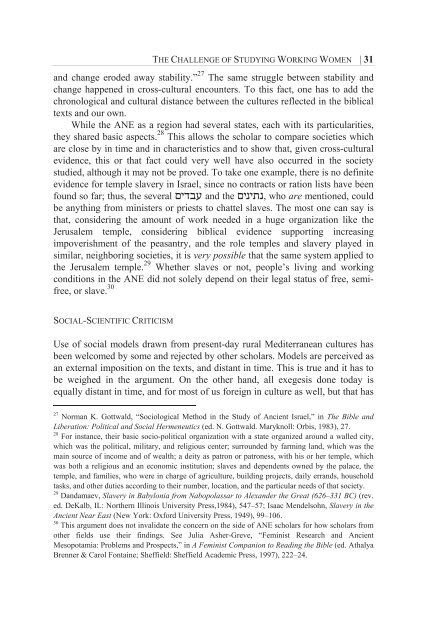Women at Work in the Deuteronomistic History - International Voices ...
Women at Work in the Deuteronomistic History - International Voices ...
Women at Work in the Deuteronomistic History - International Voices ...
You also want an ePaper? Increase the reach of your titles
YUMPU automatically turns print PDFs into web optimized ePapers that Google loves.
THE CHALLENGE OF STUDYING WORKING WOMEN | 31<br />
and change eroded away stability.” 27 The same struggle between stability and<br />
change happened <strong>in</strong> cross-cultural encounters. To this fact, one has to add <strong>the</strong><br />
chronological and cultural distance between <strong>the</strong> cultures reflected <strong>in</strong> <strong>the</strong> biblical<br />
texts and our own.<br />
While <strong>the</strong> ANE as a region had several st<strong>at</strong>es, each with its particularities,<br />
<strong>the</strong>y shared basic aspects. 28 This allows <strong>the</strong> scholar to compare societies which<br />
are close by <strong>in</strong> time and <strong>in</strong> characteristics and to show th<strong>at</strong>, given cross-cultural<br />
evidence, this or th<strong>at</strong> fact could very well have also occurred <strong>in</strong> <strong>the</strong> society<br />
studied, although it may not be proved. To take one example, <strong>the</strong>re is no def<strong>in</strong>ite<br />
evidence for temple slavery <strong>in</strong> Israel, s<strong>in</strong>ce no contracts or r<strong>at</strong>ion lists have been<br />
found so far; thus, <strong>the</strong> several םידבע and <strong>the</strong> םיניתנ, who are mentioned, could<br />
be anyth<strong>in</strong>g from m<strong>in</strong>isters or priests to ch<strong>at</strong>tel slaves. The most one can say is<br />
th<strong>at</strong>, consider<strong>in</strong>g <strong>the</strong> amount of work needed <strong>in</strong> a huge organiz<strong>at</strong>ion like <strong>the</strong><br />
Jerusalem temple, consider<strong>in</strong>g biblical evidence support<strong>in</strong>g <strong>in</strong>creas<strong>in</strong>g<br />
impoverishment of <strong>the</strong> peasantry, and <strong>the</strong> role temples and slavery played <strong>in</strong><br />
similar, neighbor<strong>in</strong>g societies, it is very possible th<strong>at</strong> <strong>the</strong> same system applied to<br />
<strong>the</strong> Jerusalem temple. 29 Whe<strong>the</strong>r slaves or not, people’s liv<strong>in</strong>g and work<strong>in</strong>g<br />
conditions <strong>in</strong> <strong>the</strong> ANE did not solely depend on <strong>the</strong>ir legal st<strong>at</strong>us of free, semifree,<br />
or slave. 30<br />
SOCIAL-SCIENTIFIC CRITICISM<br />
Use of social models drawn from present-day rural Mediterranean cultures has<br />
been welcomed by some and rejected by o<strong>the</strong>r scholars. Models are perceived as<br />
an external imposition on <strong>the</strong> texts, and distant <strong>in</strong> time. This is true and it has to<br />
be weighed <strong>in</strong> <strong>the</strong> argument. On <strong>the</strong> o<strong>the</strong>r hand, all exegesis done today is<br />
equally distant <strong>in</strong> time, and for most of us foreign <strong>in</strong> culture as well, but th<strong>at</strong> has<br />
27 Norman K. Gottwald, “Sociological Method <strong>in</strong> <strong>the</strong> Study of Ancient Israel,” <strong>in</strong> The Bible and<br />
Liber<strong>at</strong>ion: Political and Social Hermeneutics (ed. N. Gottwald. Maryknoll: Orbis, 1983), 27.<br />
28 For <strong>in</strong>stance, <strong>the</strong>ir basic socio-political organiz<strong>at</strong>ion with a st<strong>at</strong>e organized around a walled city,<br />
which was <strong>the</strong> political, military, and religious center; surrounded by farm<strong>in</strong>g land, which was <strong>the</strong><br />
ma<strong>in</strong> source of <strong>in</strong>come and of wealth; a deity as p<strong>at</strong>ron or p<strong>at</strong>roness, with his or her temple, which<br />
was both a religious and an economic <strong>in</strong>stitution; slaves and dependents owned by <strong>the</strong> palace, <strong>the</strong><br />
temple, and families, who were <strong>in</strong> charge of agriculture, build<strong>in</strong>g projects, daily errands, household<br />
tasks, and o<strong>the</strong>r duties accord<strong>in</strong>g to <strong>the</strong>ir number, loc<strong>at</strong>ion, and <strong>the</strong> particular needs of th<strong>at</strong> society.<br />
29 Dandamaev, Slavery <strong>in</strong> Babylonia from Nabopolassar to Alexander <strong>the</strong> Gre<strong>at</strong> (626–331 BC) (rev.<br />
ed. DeKalb, IL: Nor<strong>the</strong>rn Ill<strong>in</strong>ois University Press,1984), 547–57; Isaac Mendelsohn, Slavery <strong>in</strong> <strong>the</strong><br />
Ancient Near East (New York: Oxford University Press, 1949), 99–106.<br />
30 This argument does not <strong>in</strong>valid<strong>at</strong>e <strong>the</strong> concern on <strong>the</strong> side of ANE scholars for how scholars from<br />
o<strong>the</strong>r fields use <strong>the</strong>ir f<strong>in</strong>d<strong>in</strong>gs. See Julia Asher-Greve, “Fem<strong>in</strong>ist Research and Ancient<br />
Mesopotamia: Problems and Prospects,” <strong>in</strong> A Fem<strong>in</strong>ist Companion to Read<strong>in</strong>g <strong>the</strong> Bible (ed. Athalya<br />
Brenner & Carol Fonta<strong>in</strong>e; Sheffield: Sheffield Academic Press, 1997), 222–24.




